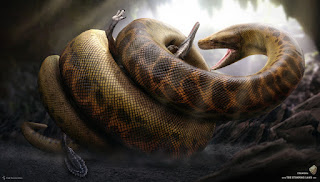Thursday, March 30, 2017
7 Animals You'll Be Glad Are Extinct
7: The Dire Wolf
During the Pleistocene, the dire wolf also known as Canis dirus inhabited different areas around North and South America. Although the average dire wolf was similar in size to the larger specimens of present day’s grey wolf, its vicious bite was the strongest of any Canis species to date. Their teeth were also larger and featured a greater shearing ability. It is also believed that they used their bite to crush the bones of their prey and eat the marrow in order to extract the maximum nutritional capacity out of each kill. Based on the numerous specimens recovered from the La Brea
6: The Smilodon
The smilodon is one of the best known species of what is commonly known as the saber-toothed cat. Smilodons inhabited regions in the Americas during the Pleistocene era, around 1.6 million to 10.000 years ago. Thousands of smilodon fossil specimens were discovered in the La Brea Tar Pits in Los Angeles, US. Their most distinctive features were their canines which could grow as long as 12 inches for the Smilodon populator, the largest of the smilodon species. Their height was estimated
5: The Terror Bird
The Phorusrhacidae also known as the terror birds were a type of large carnivorous flightless bird. It was the apex predator in the South American region, during the Cenozoic era. Terror birds ranged in height with the largest specimens standing almost 10 feet tall. They had large heads and powerful beaks but also great flexibility in their long necks. This enabled them to deliver devastating strikes on their prey. They would often use their height as a means of intimidation. Before delivering a downward attack
4: The Spinosaurus
Similar to the T-Rex the Spinosaurus was also a theropod dinosaur meaning that it was a massive land carnivore. It lived during the Cretaceous period, approximately 112 to 97 million years ago, mainly in the swamps of North Africa. Its scientific name, which translates to ‘spine lizard’, reflects the dinosaur’s most distinctive feature. The Spinosaurus had tall neural spines growing on its back vertebrae which were connected to each other by skin to form what scientists have referred to as the ‘sail’. The sail’s function is still unclear. With its sail fully extended the Spinosaurus
3: The Titanoboa
The titanoboa is the largest genus of snake ever discovered with an estimated weight of 2.500 pounds and a length of almost 50 feet. Upon its discovery it was believed that the titanoboa was an apex predator of the Palogene epoch inhabiting Earth’s tropical regions approximately 50-60 million years ago. However, later analysis indicated that the snake was mainly piscivorous, meaning that its diet consisted mostly of fish. When it would take on larger prey, the serpent would use its massive body to constrict its prey
2: The Tyrannosaurus Rex
The name ‘Rex’ comes from Latin and translates as ‘king’. Considering the fact that the Tyrannosaurus Rex is one of the largest predators that have ever lived, the name does it justice. The T-Rex was one of the few non-avian dinosaurs that were still roaming the Earth, prior to the Cretaceous-Paleogene extinction event (K-Pg). The leading theory behind the K-Pg event is that a large asteroid brought about the mass extinction of approximately three quarters of all the plant and animal life on Earth. The largest complete T-Rex specimen is located at the Field Museum of Natural History, in Chicago and measures 40 feet in length and stands at 12 feet tall. Based on the bone structure it is estimated
1: The Megalodon
The megalodon was one of the most dangerous predators in the sea during the Pliocene and Miocene epochs, around 23 to 2.6 million years ago. Based on the size of the discovered teeth and vertebrae, it was determined that the megalodon’s physical appearance resembled that of today’s great white shark. However, the megalodon was much larger. Based on the fossil evidence and body mass analysis which was done in comparison with that of the great white it was estimated that the length of the megalodon ranged from 55 to 60 meters in length with a weight between 50 and 75 tons. Scientists have not excluded the possibility of certain specimens exceeding these parameters. A 2008 computer simulation determined that the 10.8 to 18.2 ton bite force that this shark could produce was stronger than that of any other animal
Subscribe to:
Post Comments (Atom)



















No comments:
Post a Comment